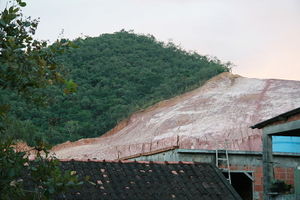Knowledge fuels change - Support energypedia!
For over 10 years, energypedia has been connecting energy experts around the world — helping them share knowledge, learn from each other, and accelerate the global energy transition.
Today, we ask for your support to keep this platform free and accessible to all.
Even a small contribution makes a big difference! If just 10–20% of our 60,000+ monthly visitors donated the equivalent of a cup of coffee — €5 — Energypedia would be fully funded for a whole year.
Is the knowledge you’ve gained through Energypedia this year worth €5 or more?
Your donation keeps the platform running, helps us create new knowledge products, and contributes directly to achieving SDG 7.
Thank you for your support, your donation, big or small, truly matters!
Bioenergy Decision Support Tool
Overview
The Bioenergy Decision Support Tool (DST) provides stepwise guidance to decision makers in governments to develop
sustainable bioenergy policies and strategies, and to assess investment proposals. It was created as an interactive tool in e-book form which provides the full text and can be printed.
The DST was developed jointly by the Food and Agricultural Organization of the United Nations (FAO) and the United Nations Environment Programme (UNEP) under the framework of UN-Energy.
The Techno–Economic Background
The Techno-Economic Background provides the basics of bioenergy, such as explanations and definitions of the various bioenergy technologies, feedstocks and applications of bioenergy as well as examples for bioenergy production chains:
- Definitions and Terms
- Biomass Resources
- Bioenergy Production Chain
- Sectors and Applications
- Bioenergy Conversion Processes
- Bioenergy Systems
- Liquid and Gaseous Fuels
►Read More: Techno-Economic Background
Designing a Strategy
Designing a Strategy answers important questions acting as cornerstones for the use of bioenergy: Who, Why, Which, What, Where and How?
- Who is involved?
- Why should actors pursue a bioenergy strategy?
- Which sectors demand bioenergy?
- What bioenergy feedstocks and technologies should be pursued to meet national objectives?
- Where can bioenergy be geographically implemented?
- How can the best opportunities for smallholders and land owners be created?
►Read More: Designing a Strategy
Implementation and Operation
Implementation and Operation introduces to important aspects of bioenergy such as developing supporting policy framework, linking the strategy to existing/potential programs and organizing the set-up in order to successfully interact with technical, financial and administrative stakeholders:
- Resource Ownership: Types and Impacts
- Small-Scale Schemes: Opportunities and Risks
- Devising an Implementation Strategy
- Establishing Legal and Regulatory Frameworks
- Program Development
- Integrating with Energy and Resource Baselines
- Monitoring, Measurement, Reporting and Evaluation
►Read More: Implementation and Operation
Project Screening
Decisions on the allocation of land and granting operating licenses to bioenergy investments (inter alia those funded by international investors) become a more and more important theme for government authorities. Many of the same questions, which arose in the bioenergy strategy, need to be considered in order to make an informed and responsible decision on whether to go ahead with a particular investment project or what types of conditions to include in the eventual license agreement or how to form and implement a publicly funded bioenergy investment project. This section will examine the decision process for reviewing project proposals in order to fit the national bioenergy strategy with concrete projects:
- Defining the Project Proposals
- Evaluating Compability with Bioenergy Strategy
- Stakeholder Processes
- Impact Assessment
- Financial Viability
►Read More: Project Screening
Land Resources
Increasing land pressures will require a good management of biofuels expansion in order to prevent loss of biodiversity and
damage to ecosystem. In this section, key drivers and analytical approaches associated with the allocation of land resources for bioenergy production as well as an overview of land use for bioenergy systems is provided:
- Land Use Efficiency
- Land Resource Assessment
- High Carbon Content Environments
- High Biodiversity Environments
- Marginal and Degraded Lands
►Read More: Land Resources
People and Processes
In order to ensure a good planning of a bioenergy project, it is important to define the roles of the various actors engaged. In this section, deeper background knowledge is provided on some of the people-process systems that are important in the design and implementation of a bioenergy strategy:
- Participation of Stakeholders
- Governance
- Community Engagements in Projects
- MMRE
►Read More: People and Processes
Deployment and Good Practices
The success of deployed bioenergy technologies depends on the institutional mechanisms and the supporting infrastructure. Good practices make the operation of bioenergy systems more sustainable. Combining effective deployment and good practice supports the implementation and success of bioenergy strategies. In this section, an overview of good practices in agriculture and forestry is presented. It also gives concrete examples of innovative deployment and/or good practice.
The chapter Deployment and Good Practices contains the following parts:
- Deployment of Bioenergy Systems
- Integrated Food Energy Systems
- Co-Products
- Sustainable Agricultural Practices
- Sustainable Forest Management
►Read More: Deployment and Good Practices
Evaluating Impacts
Questions for key environmental and socio-economic impacts are provided in this module and will help to examine impacts from bioenergy systems. They are grouped into four main categories:
- Food security
- Environment and natural resources
- Climate and emissions
- Socio-economic impacts
The impacts and questions reviewed are most appropriate for the evaluation of large-scale projects.
►Read More: Evaluating Impacts





















